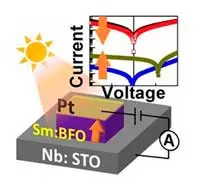 Work undertaken at the King Abdullah University of Science and Technology could lead to smaller memory chips that consume less power and which can be controlled and probed by light.
Work undertaken at the King Abdullah University of Science and Technology could lead to smaller memory chips that consume less power and which can be controlled and probed by light.
The technology is based on a ferroelectric tunnel junction (FTJ) – in which a thin layer of a ferroelectric material is sandwiched between two electrodes. In this case, a layer of samarium doped bismuth iron oxide (SBFO) – ranging in thickness from 3 to 9nm – was placed between platinum and niobium doped strontium titanate, which is light sensitive.
In one of its polarisation states, SBFO has a low tunnelling electroresistance (TER) that allows electrons to pass. However, in its other polarisation state, the TER is 100,000 times larger, which prevents tunnelling. According to the researchers, this is the largest change in TER ever seen for a FTJ and provides an ‘unambiguous’ way to read polarisation state. However, when exposed to ultraviolet light, TER was reduced by a factor of 10.
“This means that we could acquire four electronic states, corresponding to polarisation direction (left or right) and illumination condition (dark or light),” noted researcher Tom Wu. “Each electronic state can be used to store one bit of information. By introducing light into FTJs, we double the data storage density, which could be very promising for future technology.”
Switching from one state to another took 10µs, said to be faster than conventional flash, but slower than some other forms of memory. Meanwhile, while the difference in TER between the two states is said to decrease gradually, the team believes the approach will still be suitable for long term data storage.
“One immediate goal of our research is to make these FTJ devices smaller and faster,” said Wu. “In addition, we will work to enhance the light detection capability of such ultrathin junctions.”
Author
Graham Pitcher
Source: www.newelectronics.co.uk
